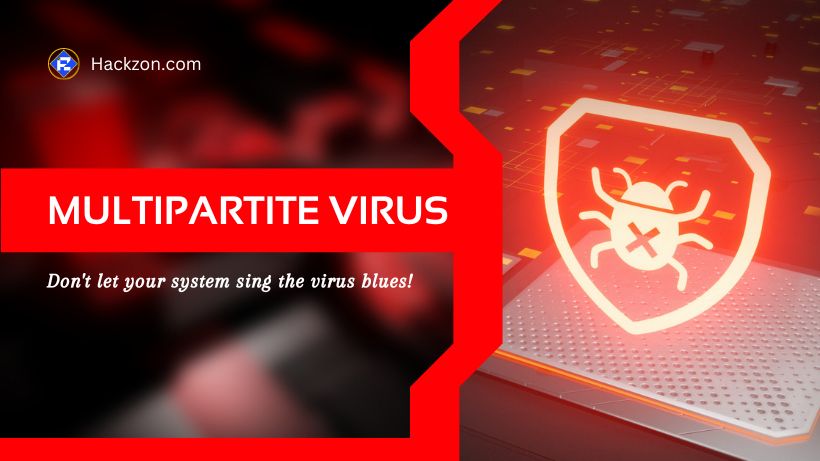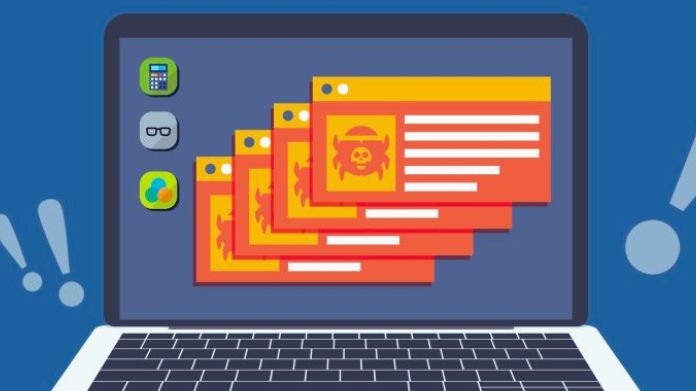Virus
What Does Multipartite Virus Mean and Removal Techniques
Get insights into multipartite viruses and their multifaceted nature. Learn how to defend your computer against these intricate malware threats.

In cybersecurity, multipartite viruses stand out for their unique and challenging characteristics.
In today’s cyber age, staying informed about potential digital threats is crucial.
In this guide, Hackzon checks what multipartite viruses are, how they work, their impact on computer systems, and, most importantly, how to protect your devices from these persistent threats.
So, fasten your virtual seatbelts, and let’s embark on this journey to safeguarding your digital world.
What is a Multipartite Virus?
A multipartite virus is like a supercharged computer bug that can mess up your device in multiple ways.
In 1989, Friðrik Skúlason discovered the Ghostball virus, marking the birth of the first multipartite virus in computer history.
Unlike regular viruses that attack one thing at a time, these nasties reach two big targets: your device’s boot sector (the part that starts your computer) and its executable files like the boot sector virus.
This double trouble makes multipartite viruses more destructive. They can sneak into your system multiple times, at different moments, and hang out in secret corners.
To get rid of them, you’ve got to track down every bit of the virus, or it will just keep coming back and causing havoc.
These baddies aren’t new; the first one, Ghostball, showed up in 1989. It didn’t spread much back then because the internet was still young.
But now, with so many people online, multipartite viruses can cause significant problems for regular folks and businesses.
These viruses are unique because they mess with your computer with two tricks. One type, called boot infectors, goes after the boot sector.
The other type, file infectors, messes with your executable files. By doing both at once, they can wreck your computer’s day.
Definition
“A multipartite virus is malicious software that exhibits a dual attack capability by infecting a computer’s boot sector and executable files concurrently.
These viruses are notorious for their resilience and ability to repeatedly infect a system, often causing extensive damage to files and system operations. ”
How Does the Multipartite Virus Work?

Multipartite viruses are complex and hybrid, making them particularly challenging to eradicate.
To understand how these viruses work, let’s see their mechanisms:
- Dual Attack: Multipartite viruses are named for their ability to attack a computer system on multiple fronts. They target both the boot sector and executable files simultaneously. This dual approach distinguishes them from viruses like Dike or Polymorphic, which typically focus on one area.
- Infection Process: When a multipartite virus infects a system, it usually starts by infiltrating the boot sector. It is the first code executed when a computer boots up. The virus activates whenever the computer is turned on by embedding itself in the boot sector.
- Payload Delivery: Along with infecting the boot sector, it carries a destructive payload. This payload is a set of malicious instructions or code that the virus executes once it gains control of the system. This destructive payload can corrupt files, disrupt system operations, or render the computer unusable.
- Multiple Infections: Multipartite viruses are known for their ability to infect a system repeatedly over time. They may do so at varying intervals and rates, making them persistent and challenging to remove. Each reinfection further compromises the system’s integrity.
Symptoms of a Multipartite Virus
Does your computer have a sneaky Multipartite Virus? Look out for these signs:
- Sluggish Speed: Watch out if your computer suddenly feels slower than a sloth. These Viruses can make your computer run at a snail’s pace, which is frustrating.
- Repetitive Crashes: Does your system keep crashing and restarting on its own? That’s a red flag. These viruses can cause your computer to throw a fit and reboot repeatedly.
- App Frustration: Trouble launching apps? The Virus might be playing tricks. It can prevent your applications from starting, making work or play nearly impossible.
- Internet Woes: If your internet connection fails more often, it could be virus trouble. Multipartite Viruses can interfere with your ability to connect online, leading to frustrating failed attempts.
- Antivirus Annoyance: If your antivirus gets mysteriously disabled, that’s not a good sign. It can cleverly shut down your antivirus protection, leaving your computer vulnerable.
- Vanishing Files: Missing files? The Multipartite Virus may be gobbling them up. It can make your saved files disappear, causing you to lose valuable data.
Impact on Businesses
Multipartite viruses can harm businesses in various ways. They’re tough to remove and might linger in the boot sector, leading to repeated infections.
These viruses gobble up storage space and corrupt files, potentially causing significant losses for companies.
How to Remove a Multipartite Virus?
Getting rid of a tricky multipartite virus can be challenging, but here’s how you can do it:
Method 1: Trusty Antivirus Software
- Use a reputable antivirus program like Bitdefender, Norton, McAfee, Trend Micro, or Avast.
- Run a scan with up-to-date antivirus software when you suspect a multipartite virus.
Method 2: Rescue, Reboot, and Run
- Create a bootable rescue disc with your antivirus software.
- Insert an empty disc and set it up.
- Search for “System Repair Disc” and create the disc.
- Reboot your computer and wait.
- Navigate to the setup section and select the CD/DVD option.
- The computer will boot from the recovery disc.
- Let the antivirus software run a virus scan and remove it.
- Restart your computer once the virus is gone.
These methods can help you tackle a virus and get your computer back on track.
Protecting Your Computer From Multipartite Viruses
Shielding your computer from tricky multipartite viruses is crucial, as they’re tough to shake.
New variants pop up daily, making prevention vital while no defense is perfect.
Here’s how you can guard your computer:
- Quality Antivirus Software: Install trustworthy antivirus or anti-malware Software from reliable vendors to stay prepared against potential attacks.
- Regular File Backups: Safeguard your essential files by backing them to the cloud or external devices. It ensures your data’s safety in case of an infection.
- Beware of Suspicious Links: Pay attention to URLs before clicking on links, and look for security icons like a lock and shield on websites. Avoid downloading freeware from untrusted sources.
- Keep Software Updated: Cybercriminals exploit outdated Software and operating systems. Keep your computer programs, OS, and antivirus software up-to-date to fend off attacks.
- Avoid Unsolicited Messages: Don’t open email attachments from untrusted sources. Phishing emails often contain harmful links that can harm your computer.
- Act Swiftly: If you see pop-ups, shut down your computer immediately.
- Preventative Measures: These viruses are tricky to eliminate, so rely on up-to-date virus protection.
Wrapping Words
Now that we’ve uncovered the details of multipartite viruses and discovered efficient removal methods, you may be thinking, “What’s next?”
The digital landscape is ever-evolving, so remaining watchful is essential. Regular updates, powerful antivirus software, and safe surfing habits may all help to protect your PC.
Stay safe out there!

















James Romes
December 25, 2024 at 6:52 am
Great article! Your explanation of multipartite viruses and how they operate is both clear and informative. I appreciate the emphasis on prevention tips and how to protect systems from these complex threats. This is a must-read for anyone wanting to stay safe in the digital world.
admin
December 26, 2024 at 12:39 pm
Yes, James. This article helps to more people.